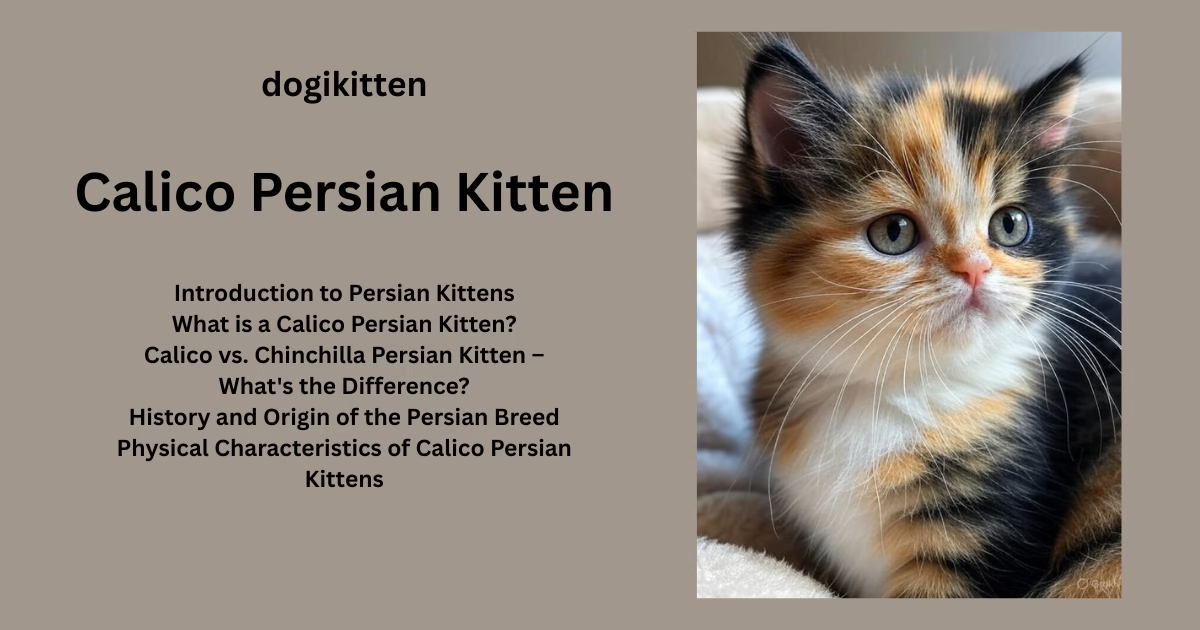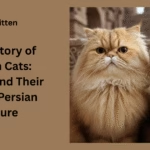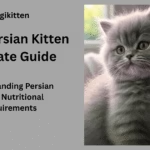
Explore the beauty, care, personality, and price of the Calico Persian Kitten. Discover the differences between Calico and Chinchilla Persian Kittens, grooming tips, and how to choose your perfect Persian kitten.
1.Introduction to Persian Kittens
2.What is a Calico Persian Kitten?
3.Calico vs. Chinchilla Persian Kitten – What’s the Difference?
4.History and Origin of the Persian Breed
5.Physical Characteristics of Calico Persian Kittens
6.Personality and Temperament
7.Grooming Needs of Persian Kittens
8.Diet and Nutrition for Persian Kittens
9.Health Issues and Lifespan
10.Training and Socialization
11.Living Environment for a Calico Persian
12.Cost of Calico and Chinchilla Persian Kittens
13.Choosing a Responsible Breeder or Adoption
14.How to Prepare Your Home for a Persian Kitten
15.Bonding and Enrichment Activities
16.Similar Persian Varieties
17.Is a Persian Kitten Right for You?
18.Conclusion
19. FAQ
Introduction to Persian Kittens
The Persian kitten is one of the most beloved cat breeds worldwide. With their luxurious long fur, expressive eyes, and calm demeanor, they are often considered the aristocrats of the feline world. Among the many Persian variants, Calico Persian Kittens stand out for their unique tricolor coats, while the Chinchilla Persian Kitten, known for its silver or golden shimmer, is equally adored for its glamour and charm.
2. What is a Calico Persian Kitten?
A Calico Persian Kitten is a beautiful and rare variety of the Persian cat breed, known for its long, luxurious coat and a distinctive tri-color pattern. The colors typically include white as the base, with large patches of black and orange or cream. This color combination is not a breed characteristic but a genetic color variation that appears in Persian cats, among others.
Calico Persian kittens inherit all the classic features of the Persian breed:
- A round face with big, expressive eyes (often copper or golden in color)
- A short, flat nose (in flat-faced or “Peke-faced” types) or slightly protruding nose (in doll-faced Persians)
- A thick, flowing coat that requires daily grooming to prevent tangles and matting
- A sweet and gentle personality, making them ideal indoor companions
One fascinating fact about Calico kittens is that almost all of them are female, due to how the orange and black colors are carried on the X chromosome. Male Calico Persians are extremely rare and often sterile because they require a rare genetic condition (XXY chromosomes).
While Calico Persians are not a separate breed, they are considered highly desirable for their rare and vibrant coloring combined with the Persian cat’s elegant appearance and affectionate nature. They are ideal for cat lovers who want a stunning, calm, and cuddly feline companion.
3. Calico vs. Chinchilla Persian Kitten – What’s the Difference?
| Feature | Calico Persian Kitten | Chinchilla Persian Kitten |
|---|---|---|
| Coat Pattern | Tricolor (white, black, orange) | Solid white base with silver or gold tips |
| Main Color Type | Patchy, vibrant colors | Sparkling silver or golden sheen |
| Eyes | Copper or orange | Green or blue-green |
| Gender Probability | Mostly Female | Both genders |
| Popularity | Very popular due to unique patterns | High due to elegance and rarity |
While the Chinchilla Persian kitten is prized for its shimmering coat, the Calico Persian captivates with its vibrant mix of colors.
4. History and Origin of the Persian Breed
The Persian cat breed is one of the oldest and most admired cat breeds in the world, with a rich history that traces back to ancient Mesopotamia, which later became known as Persia (modern-day Iran). These cats were valued for their unusually long and silky fur, a rare trait in wild and domestic cats at the time. They were considered exotic and luxurious, often kept by nobility and wealthy traders.
The breed first reached Europe in the 1600s, when Italian explorer Pietro della Valle brought long-haired cats from Persia to Italy. Around the same time, travelers and merchants introduced similar cats from Turkey and Afghanistan. These early cats were crossbred with other long-haired breeds, gradually evolving into what we now recognize as the Persian.
By the 19th century, Persian cats gained immense popularity in England and France. Queen Victoria herself is believed to have owned blue and white Persians, adding to their royal image. Breeders began selectively enhancing features like the flat face (brachycephalic look), short nose, and the cat’s signature long, thick coat. Over time, different color patterns like Calico, Chinchilla, and Himalayan were developed.
The breed was officially recognized by major cat registries like the Cat Fanciers’ Association (CFA) and The International Cat Association (TICA) in the early 20th century. Today, Persian cats are one of the most beloved purebred cats globally, known for their graceful appearance, docile personality, and luxurious coats that require dedicated grooming.
In summary, the Persian cat’s journey—from ancient Persian kingdoms to modern showrooms and homes—reflects its enduring charm and aristocratic appeal.
5. Physical Characteristics of Calico Persian Kittens
- Size: Medium to large
- Weight: 7–12 lbs
- Coat: Long, thick, and silky
- Face Types: Doll-faced or flat-faced (Peke-faced)
- Color: White with patches of black and orange (Calico)
- Eyes: Round and expressive, usually copper-colored
Their signature feature is their tri-colored, patchy fur pattern, which is often unpredictable and unique to each kitten.
6. Personality and Temperament
The Persian kitten, whether it’s a Calico Persian, Chinchilla Persian, or any other color variety, is widely loved for its gentle, calm, and affectionate temperament. These kittens are often described as quiet, sweet-natured, and easygoing, making them ideal indoor companions, especially for people who appreciate a relaxed and low-energy pet.
💤 Calm and Quiet Nature
Persian kittens are known for their laid-back attitude. They are not hyperactive or mischievous like some other breeds. Instead, they enjoy lounging in cozy corners, resting on soft cushions, or sleeping peacefully near their favorite human. They rarely meow loudly and tend to communicate softly with purring or gentle vocalizations.
This calmness makes them perfect for people living in apartments or quiet homes where a peaceful pet is preferred.
🐾 Affectionate and Loyal
Persians form strong bonds with their owners, often following them from room to room, sitting beside them, or curling up in their lap. They are not overly demanding for attention, but they appreciate gentle cuddles, head rubs, and spending quality time with their family.
While they are loving, they’re also a bit reserved, especially around strangers. It may take them some time to warm up to new people, but once they do, they are very affectionate and loyal.
🎯 Not Attention-Seeking, but Emotionally Aware
Unlike some cats that constantly seek attention, Persian kittens are independent yet emotionally sensitive. They can sense their owner’s mood and often act as a comforting presence. They are the type of cat that will quietly sit with you after a long day, providing silent companionship rather than demanding play.
🧒 Gentle Around Children and Seniors
Due to their gentle temperament, Persian kittens are excellent around children and older adults. They’re not aggressive or prone to scratching unless provoked. Their calm behavior makes them safe and predictable, although young children should always be taught to handle them gently.
🐶 Gets Along With Other Pets
Persians usually tolerate other pets well, especially if they are introduced properly and slowly. They are not territorial or dominant and prefer to avoid conflict. They often coexist peacefully with other cats, small dogs, or quiet animal companions.
🎲 Playful but Not Hyperactive
Persian kittens do enjoy play, especially when young. They like feather wands, soft plush toys, or anything they can bat with their paws. However, their play sessions are usually short and not very intense. Unlike active breeds like the Bengal or Siamese, Persians prefer a slower pace of life.
Some Calico Persians may show a touch of sass or playfulness, possibly due to the genetic diversity linked with their unique coat patterns. However, they still retain the core Persian personality traits—dignified, elegant, and serene.
📌 Sensitive to Changes
Persians thrive in a stable and predictable environment. They are not big fans of change—whether it’s a move to a new house, frequent loud noises, or unfamiliar guests. Sudden changes can make them anxious or withdrawn.
Creating a consistent routine for feeding, grooming, and playtime helps Persian kittens feel secure and happy.
Summary of Persian Kitten Personality:
| Trait | Description |
|---|---|
| Energy Level | Low to moderate |
| Friendliness | Very affectionate with family, shy with guests |
| Playfulness | Gentle, prefers short play sessions |
| Noise Level | Quiet, soft meows |
| Adaptability | Low to moderate; prefers stable routine |
| Social Compatibility | Good with kids, seniors, and other pets |
- Quiet and gentle
- Enjoys lounging and cuddling
- Can be playful but not hyperactive
- Bonds closely with one or two family members
7. Grooming Needs of Persian Kittens
Persian kittens, including Calico and Chinchilla Persian kittens, are famous for their long, thick, and silky coats. While this luxurious fur is one of their most attractive features, it also requires regular and dedicated grooming to keep them healthy, clean, and comfortable.
Without consistent grooming, Persian kittens are prone to matting, hairballs, skin infections, and tear staining. Here’s a complete guide to their grooming needs:
1. Daily Brushing
Why it’s important:
Persian fur is dense and prone to tangling. If not brushed daily, it quickly forms mats—tight, painful clumps of fur close to the skin.
Tips:
- Use a wide-toothed metal comb and a soft slicker brush.
- Always brush gently to avoid hurting the kitten.
- Focus on problem areas like under the legs, around the neck, belly, and behind the ears.
- Start brushing from a young age so your kitten gets used to it.
🛁 2. Regular Bathing
Frequency:
- Once every 2 to 4 weeks is ideal, depending on coat condition and lifestyle.
Why it’s necessary:
- Keeps the coat soft and free of oil buildup.
- Reduces dander and loose hair (which causes hairballs).
- Maintains a fresh, clean scent.
Bathing Tips:
- Use a cat-safe shampoo formulated for long-haired breeds.
- Rinse thoroughly and dry completely with a soft towel and, if tolerated, a blow dryer on low heat.
- Make bath time stress-free by introducing it slowly and using treats.
🧼 3. Eye Cleaning
Flat-faced Persians often have tear overflow, causing tear stains on their face. This is especially visible on light-colored kittens like Chinchilla Persians.
How to clean:
- Wipe eyes daily with a damp cotton pad or vet-recommended eye wipes.
- Be gentle, and use a fresh pad for each eye to avoid spreading infection.
🐾 4. Ear Cleaning and Nail Trimming
Ears:
- Check weekly for dirt, wax, or signs of infection.
- Use a soft cotton ball with a vet-approved ear cleaner.
Nails:
- Trim every 2–3 weeks using a pet nail clipper.
- Gently press the paw pad to extend the claw and avoid cutting into the pink area (quick).
🪑 5. Managing Shedding and Hairballs
- Persian kittens shed year-round, with heavier shedding during seasonal changes.
- Daily brushing helps reduce hair swallowed during self-grooming.
- To prevent hairballs, provide a hairball control diet or treats with malt extract.
🧴 6. Professional Grooming
Consider taking your Persian kitten to a professional groomer every 2–3 months for:
- Deep coat cleaning
- Sanitary trims (especially around the tail and rear)
- Clipping matted areas safely
Professional help is especially useful if you’re unable to maintain the coat daily due to a busy schedule.
🧶 7. Tips to Make Grooming Easier
- Start grooming as early as 8–10 weeks old.
- Keep grooming sessions short and positive with gentle praise or treats.
- Create a routine so the kitten knows what to expect.
- Use a non-slip surface during baths and brushing.
Summary Table – Grooming Checklist for Persian Kittens:
| Task | Frequency | Tools Needed |
|---|---|---|
| Brushing | Daily | Metal comb, slicker brush |
| Bathing | Every 2–4 weeks | Cat-safe shampoo, towel, blow dryer |
| Eye Cleaning | Daily | Soft cotton pad or pet eye wipes |
| Ear Cleaning | Weekly | Cotton ball, vet-approved ear cleaner |
| Nail Trimming | Every 2–3 weeks | Pet nail clipper |
| Professional Grooming | Every 2–3 months | Groomer visit for trim & bath |
8. Diet and Nutrition for Persian Kittens
A healthy diet helps maintain their shiny coat and overall well-being.
- High-Protein Food: Chicken, fish, turkey
- Low Grains: Avoid corn or wheat fillers
- Wet and Dry Food Mix: Keeps hydration balanced
- Supplements: Omega-3 for coat health
Always choose vet-recommended Persian kitten food brands.
9. Health Issues and Lifespan
Like all purebreds, Persian kittens have some genetic health risks:
Common Issues:
- Polycystic Kidney Disease (PKD)
- Dental Malocclusion
- Tear duct overflow
- Skin infections due to matting
- Breathing issues in flat-faced types
Average Lifespan:
12 to 16 years with good care
Routine vet checkups and a clean environment can prevent most complications.
10. Training and Socialization
Though Persian kittens aren’t known for tricks, they are trainable with patience.
- Litter Training: Start early with a covered box
- Basic Commands: “Come,” “Sit,” or “No” using treats
- Socialization: Introduce gently to kids, pets, and noises
- Scratching Post: Train them early to avoid furniture damage
11. Living Environment for a Calico Persian
Ideal for indoor-only homes, Persian kittens do best in quiet, secure spaces.
- Temperature: Moderate, avoid extreme heat
- Quiet Corners: For resting and alone time
- Cat Trees & Toys: For gentle play
- Safe Spaces: Away from aggressive pets or small children
12. Cost of Calico and Chinchilla Persian Kittens
| Type | Price in India (INR) | Price Globally (USD) |
|---|---|---|
| Calico Persian Kitten | ₹20,000 – ₹60,000 | $400 – $1,200 |
| Chinchilla Persian Kitten | ₹30,000 – ₹80,000 | $500 – $1,500 |
Breeding quality, pedigree, and coat quality heavily influence prices.
13. Choosing a Responsible Breeder or Adoption
Breeder Checklist:
- Health certificates
- Transparent lineage
- Clean environment
- Socialization exposure
Adoption Options:
- Cat rescue centers
- Breed-specific Persian cat shelters
- Vet clinics or referrals
14. How to Prepare Your Home for a Persian Kitten
- Purchase kitten-safe litter, food, bowls, and toys
- Set up a dedicated space or kitten room
- Ensure no toxic plants, open wires, or sharp edges
- Introduce slowly to other pets
15. Bonding and Enrichment Activities
- Use feather toys or catnip mice for play
- Talk softly and offer cuddles daily
- Use puzzle feeders for mental stimulation
- Rotate toys every few days to avoid boredom
16. Similar Persian Varieties
Besides Calico and Chinchilla, other Persian varieties include:
- Himalayan Persian (Color-point)
- Blue Persian (Solid gray)
- White Persian (Classic show variety)
- Tabby Persian (Striped pattern)
- Golden Persian (Warm, golden tones)
17. Is a Persian Kitten Right for You?
✔ Great for families or individuals seeking a low-energy, affectionate companion
✔ Ideal for indoor homes and apartment living
✘ Not suitable for people unwilling to commit to grooming or regular vet care
18. Conclusion
The Calico Persian Kitten is a beautiful and loving feline that brings color, charm, and calm into your life. Whether you’re enchanted by the elegance of the Chinchilla Persian kitten or the vibrant patchwork of the Calico, owning a Persian kitten is both a joy and a responsibility. With proper grooming, care, and affection, your Persian will be a loyal companion for years to come.
Frequently Asked Questions (FAQ)
1. Are Calico Persian Kittens rare?
Yes, especially due to the genetic rarity of the calico pattern in Persians and the fact that most are female.
2. Is a Chinchilla Persian Kitten the same as a White Persian?
No. Chinchilla Persians have a silver or golden sheen at the tips of their fur, while white Persians are solid white.
3. Can Persian kittens be left alone?
For short periods, yes. But they thrive best with companionship and a structured routine.
4. How often should I bathe my Calico Persian kitten?
Every 2–3 weeks is ideal to maintain coat cleanliness and reduce oil buildup.
5. What is the best age to bring a Persian kitten home?
8–12 weeks is considered the best age for proper development and socialization.











2 thoughts on “Calico Persian Kitten”